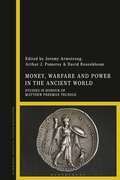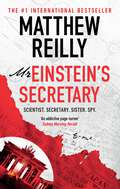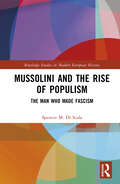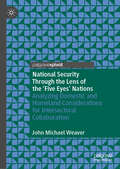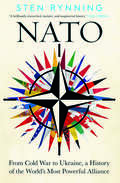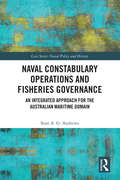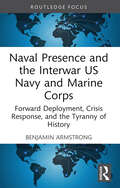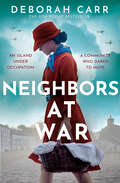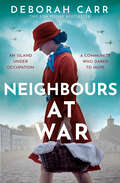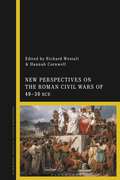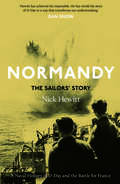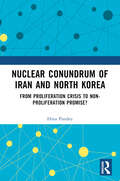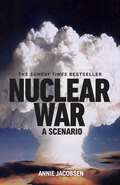- Table View
- List View
Modernising the People’s Liberation Army: Aspiring to be a Global Military Power (Asian Security Studies)
by James CharThis volume examines the progress made by the Chinese military (the People’s Liberation Army, PLA) as it strives to meet its commander-in-chief’s directive to transform itself into a more capable fighting force.The book tracks the reforms undertaken by the PLA in meeting its commander-in-chief’s grand objectives set at the 2015 Central Military Commission Reform Work Meeting: for China’s armed forces to transform themselves into a more professional and modern military. Focusing on those changes since late 2016 at corps level and below, the first and second sections of the volume document the subsequent force structure and operational changes to the PLA’s four conventional services, and two newly established PLA branches: the Strategic Support Force and Joint Logistic Support Force. To that end, the contributors examine the reforms promulgated by the Chinese high command and measure them against observable developments in the PLA’s power-projection capabilities. In view of how the instrumentalization of military power is writ large in Beijing’s strategic calculus and in regional hotspot issues, the final part of the book also provides pathbreaking insights into two critical but not so well-understood phenomena: the now regular PLA aerial activities in the Taiwan Strait and the PLA Navy’s submarine operations in the South China Sea.This book will be of much interest to students of East Asian security, Chinese politics, and military and strategic studies in general.
Modernising the People’s Liberation Army: Aspiring to be a Global Military Power (Asian Security Studies)
This volume examines the progress made by the Chinese military (the People’s Liberation Army, PLA) as it strives to meet its commander-in-chief’s directive to transform itself into a more capable fighting force.The book tracks the reforms undertaken by the PLA in meeting its commander-in-chief’s grand objectives set at the 2015 Central Military Commission Reform Work Meeting: for China’s armed forces to transform themselves into a more professional and modern military. Focusing on those changes since late 2016 at corps level and below, the first and second sections of the volume document the subsequent force structure and operational changes to the PLA’s four conventional services, and two newly established PLA branches: the Strategic Support Force and Joint Logistic Support Force. To that end, the contributors examine the reforms promulgated by the Chinese high command and measure them against observable developments in the PLA’s power-projection capabilities. In view of how the instrumentalization of military power is writ large in Beijing’s strategic calculus and in regional hotspot issues, the final part of the book also provides pathbreaking insights into two critical but not so well-understood phenomena: the now regular PLA aerial activities in the Taiwan Strait and the PLA Navy’s submarine operations in the South China Sea.This book will be of much interest to students of East Asian security, Chinese politics, and military and strategic studies in general.
Money, Warfare and Power in the Ancient World: Studies in Honour of Matthew Freeman Trundle
by Jeremy Armstrong, Arthur J. Pomeroy and David RosenbloomMoney, Warfare and Power in the Ancient World offers twelve papers analysing the processes, consequences and problems involved in the monetization of warfare and its connection to political power in antiquity. The contributions explore not only how powerful men and states used money and coinage to achieve their aims, but how these aims and methods had often already been shaped by the medium of coined money – typically with unintended consequences. These complex relationships between money, warfare and political power – both personal and collective – are explored across different cultures and socio-political systems around the ancient Mediterranean, ranging from Pharaonic Egypt to Late Antique Europe. This volume is also a tribute to the life and impact of Professor Matthew Trundle, an inspiring teacher and scholar, who was devoted to promoting the discipline of Classics in New Zealand and beyond. At the time of his death, he was writing a book on the wider importance of money in the Greek world. A central piece of this research is incorporated into this volume, completed by one of his former students, Christopher De Lisle. Additionally, Trundle had situated himself at the centre of a wide-ranging conversation on the nature of money and power in antiquity. The contributions of scholars of ancient monetization in this volume bring together many of the threads of those conversions, further advancing a field which Matthew Trundle had worked so tirelessly to promote.
A Mother’s Sorrow: The captivating new page-turner from the Queen of the Saga
by Margaret DickinsonA Mother's Sorrow is a heart-rending family saga set around WW1 from bestselling author and Queen of the Saga, Margaret Dickinson. Three young women. Two families united. A bond that can’t be broken . . . Sheffield, 1892. Patrick Halliday rules his family with a rod of iron. He’s hard on both his wife and his elder daughter, Flora, but he spoils his youngest, Mary Ellen, because she reminds him of his beloved mother.When Mary Ellen, aged seventeen, finds that she is pregnant, Patrick throws her out of the family home and Flora goes with her. After wandering the Derbyshire countryside for miles, they find shelter on a farm, working for their keep.When Flora must return to her job as a buffer girl in Sheffield’s cutlery trade, she is reunited with her friend, Evelyn Bonsor. As both young women find love and fall pregnant, the Halliday and Bonsor families are united, despite the many trials that cross their paths.Then comes the Great War. Through hardship and tragedy, these two families must stick together to weather the storm . . .
Mr Einstein's Secretary: From the creator of No. 1 Netflix thriller INTERCEPTOR
by Matthew ReillyA SECRETARY LIKE NO OTHER...IN AN EPIC SPANNING 40 YEARSAll Hanna Fischer ever wanted to do was to study physics under the great Albert Einstein.But when, as a teenager in 1919, her life is suddenly turned upside-down, she is catapulted into a new and extraordinary life - as a secretary, a scientist, a sister and a spy.From racist gangs in Berlin to gangsters in New York City, Nazis in the 1930s and Hitler's inner circle during the Second World War, Hanna will encounter some of history's greatest minds and most terrible moments, all while desperately trying to stay alive.She is a most unique secretary and she will work for many bosses - from shrewd businessmen to vile Nazis, to the greatest boss of them all, Mr Albert Einstein...Spanning forty years, this is the thrilling tale of a young woman propelled through history's most dangerous times. ***** PRAISE FOR #1 INTERNATIONAL BESTSELLER MATTHEW REILLY'Thrilling, action-packed adventure from cover to cover' Guardian'Nobody writes action like Matthew Reilly' Vince Flynn'Get ready for a wild ride' Daily Telegraph'Exciting and entertaining' Chicago Sun-Times'An action hero worthy of Lee Child' Sydney Morning HeraldUndeniably addictive' Financial Times
Museums in Israel after the Holocaust: A Multifaceted History of Cultural Heritage (Cultural Heritage, Art and Museums in the Middle East)
by Shir Gal KochaviMuseums in Israel After the Holocaust explores the influence of the traumatic events of the Holocaust on the formation of a cultural heritage policy during the foundational years of the State of Israel.Based on primary research, the book offers a new understanding of cultural practices after the Second World War, while analyzing the role of key Jewish cultural representatives who shaped museum collections that emerged during this period. The book investigates the ways Israel has dealt with the complicated history of “heirless” Jewish cultural objects and questions of ownership, by providing a detailed examination of the process of allocation of “heirless” Jewish cultural property handled by two American-Jewish organizations: the Jewish Restitution Successor Organization (JRSO) and the Jewish Cultural Reconstruction (JCR) in the immediate years following the Second World War. The book takes a material culture approach, which explores the meanings and values attached to an object over the course of time and during its transition between different owners.Museums in Israel After the Holocaust is essential reading for academics, students, and professionals working on and interested in Holocaust and Israel studies, art history, material culture studies, museum studies, cultural heritage, and Middle Eastern studies.
Museums in Israel after the Holocaust: A Multifaceted History of Cultural Heritage (Cultural Heritage, Art and Museums in the Middle East)
by Shir Gal KochaviMuseums in Israel After the Holocaust explores the influence of the traumatic events of the Holocaust on the formation of a cultural heritage policy during the foundational years of the State of Israel.Based on primary research, the book offers a new understanding of cultural practices after the Second World War, while analyzing the role of key Jewish cultural representatives who shaped museum collections that emerged during this period. The book investigates the ways Israel has dealt with the complicated history of “heirless” Jewish cultural objects and questions of ownership, by providing a detailed examination of the process of allocation of “heirless” Jewish cultural property handled by two American-Jewish organizations: the Jewish Restitution Successor Organization (JRSO) and the Jewish Cultural Reconstruction (JCR) in the immediate years following the Second World War. The book takes a material culture approach, which explores the meanings and values attached to an object over the course of time and during its transition between different owners.Museums in Israel After the Holocaust is essential reading for academics, students, and professionals working on and interested in Holocaust and Israel studies, art history, material culture studies, museum studies, cultural heritage, and Middle Eastern studies.
Mussolini and the Rise of Populism: The Man who Made Fascism (Routledge Studies in Modern European History)
by Spencer DiScalaThis book analyzes the process by which Mussolini built the world’s first Fascist regime, describes how the Duce’s heirs have adapted to current political conditions, and how they have gone mainstream. With the rise of populism of the right in the new millennium, Benito Mussolini’s name has returned forcefully to the limelight. Populist movements closely resemble historical fascism, and former President Donald J. Trump has been compared to the Duce. In 2022, the 100th anniversary of the Duce’s taking power, an Italian populist party inspired by fascism took control of the country’s government led by its first woman Prime Minister. By finding in fascism their inspiration to confront the current epoch’s deep transformations, they have taken command in a major European liberal democratic country for the first time since 1945. How this occurred demonstrates the modernity and appeal of Mussolini’s fascism and offers new perspectives in interpreting populism. While the worst elements of fascism have not yet appeared in populist movements, this book conveys in clear language, a more precise awareness of the forces and values that propelled fascism to power and that drive the march of rightist populism worldwide. This volume is essential reading for students, scholars, general observers and commentators interested in European and modern history.
Mussolini and the Rise of Populism: The Man who Made Fascism (Routledge Studies in Modern European History)
by Spencer DiScalaThis book analyzes the process by which Mussolini built the world’s first Fascist regime, describes how the Duce’s heirs have adapted to current political conditions, and how they have gone mainstream. With the rise of populism of the right in the new millennium, Benito Mussolini’s name has returned forcefully to the limelight. Populist movements closely resemble historical fascism, and former President Donald J. Trump has been compared to the Duce. In 2022, the 100th anniversary of the Duce’s taking power, an Italian populist party inspired by fascism took control of the country’s government led by its first woman Prime Minister. By finding in fascism their inspiration to confront the current epoch’s deep transformations, they have taken command in a major European liberal democratic country for the first time since 1945. How this occurred demonstrates the modernity and appeal of Mussolini’s fascism and offers new perspectives in interpreting populism. While the worst elements of fascism have not yet appeared in populist movements, this book conveys in clear language, a more precise awareness of the forces and values that propelled fascism to power and that drive the march of rightist populism worldwide. This volume is essential reading for students, scholars, general observers and commentators interested in European and modern history.
National Security Through the Lens of the ‘Five Eyes’ Nations: Analyzing Domestic and Homeland Considerations for Intersectoral Collaboration
by John Michael WeaverThis book analyzes the ‘Five Eyes’ nations’ concerns and policies relating to national security threats through an interdisciplinary theoretical engagement with the Political, Information, Security and Economic (PISE) Model. Through the analysis of secondary data sources such as scholarly and government reports, policy documents, press releases and interviews, the author analyzes the five case studies—Australia, Canada, New Zealand, UK, and the USA—to determine how and why nations use the PISE variables to shape favorable homeland security outcomes, to determine what the points of homeland intersectoral collaboration are among the ‘Five Eyes’ nations. In so doing, Weaver determines that although the ‘Five Eyes’ countries have concerns about homeland security and each, individually, identifies threats and hazards, they do also employ collaborative measures to build resilience and increase efforts to prepare for anticipated security breaches.
NATO: From Cold War to Ukraine, a History of the World's Most Powerful Alliance
by Sten RynningA wide-ranging new history of NATO, from its origins to the present day—published for the alliance’s seventy-fifth anniversary For seven decades, NATO’s stated aim has been the achievement of world peace—but playing great power politics always involves conflict. Russia’s war on Ukraine and on Europe’s security order puts the alliance under threat, but also demonstrates why transatlantic cooperation is so necessary. But how did NATO get to where it is today, and what does its future hold? In this incisive new account, Sten Rynning traces the full history of the North Atlantic Treaty Organisation from its origins to the present. Across its seventy-five years, NATO has navigated the twists and turns of Cold War diplomacy and nuclear deterrence, and has grown its membership. The alliance has become a guarantor of peace, but Rynning explores how its complex inner workings alongside Russian and Chinese opposition are now shaping its direction. At a time of strategic competition and geopolitical upheaval, Rynning offers us a clear-sighted account of the alliance’s intriguing history—and asks what its ambitions might be for the future.
Naval Constabulary Operations and Fisheries Governance: An Integrated Approach for the Australian Maritime Domain (ISSN)
by Sean A. AndrewsThis book offers an analysis of naval constabulary operations, in particular Australian fisheries patrols, and challenges the widely accepted Anglo-American school of maritime thought.In the Indo-Pacific, fisheries and the activities of fishing boats are of increasing strategic importance in Australia’s region – Australia’s Four Oceans. Issues of overfishing, population growth and climate change are placing growing pressure on fish as a resource, and in doing so are making fisheries more significant, and significant on a strategic as opposed to simply an economic or environmental level. When, combined with the growing use of fishing vessels as para-naval forces, it is clear that the activities of fishing vessels, whether fishing or not fishing, are matters of considerable strategic relevance. This book illuminates contemporary seapower challenges, explains and defines maritime security and examines and refines existing theory to advance a set of new or refined concepts to help frame the on-water activities of constabulary operations -- reducing the possibility of on-water miscalculation between states.This book will be of much interest to students and scholars of naval studies and sea power, maritime strategy, maritime security and International Relations.
Naval Constabulary Operations and Fisheries Governance: An Integrated Approach for the Australian Maritime Domain (ISSN)
by Sean A. AndrewsThis book offers an analysis of naval constabulary operations, in particular Australian fisheries patrols, and challenges the widely accepted Anglo-American school of maritime thought.In the Indo-Pacific, fisheries and the activities of fishing boats are of increasing strategic importance in Australia’s region – Australia’s Four Oceans. Issues of overfishing, population growth and climate change are placing growing pressure on fish as a resource, and in doing so are making fisheries more significant, and significant on a strategic as opposed to simply an economic or environmental level. When, combined with the growing use of fishing vessels as para-naval forces, it is clear that the activities of fishing vessels, whether fishing or not fishing, are matters of considerable strategic relevance. This book illuminates contemporary seapower challenges, explains and defines maritime security and examines and refines existing theory to advance a set of new or refined concepts to help frame the on-water activities of constabulary operations -- reducing the possibility of on-water miscalculation between states.This book will be of much interest to students and scholars of naval studies and sea power, maritime strategy, maritime security and International Relations.
Naval Presence and the Interwar US Navy and Marine Corps: Forward Deployment, Crisis Response, and the Tyranny of History (Corbett Centre for Maritime Policy Studies Series)
by Benjamin ArmstrongThis book examines the US Navy and Marine Corps during the interwar years from a new perspective. Rather than focusing on the technologies developed, the wargames conducted, or the results of the now famous Fleet Problems, this work analyzes the global deployments of the rest of the US fleet. By examining the annual reports of the Secretary of the Navy, the Chief of Naval Operations, and the Commandant of the Marine Corps over twenty years, the book traces the US ships, squadrons, and fleets conducting naval diplomacy and humanitarian missions, maritime security patrols, and deployments for deterrent effect across the world’s oceans. Despite the common label of the interwar years as “isolationist,” the deployments of the US Navy and Marine Corps in that period were anything but, the majority of the literature on the era has a narrow focus on preparation for combat and wartime, which provides an incomplete view of the history of US naval power and also establishes a misleading set of precedents and historical context for naval thinkers and strategists in the contemporary world. Offering a wider, and more complete understanding of the history of the U.S. Navy and Marine Corps from 1920 to 1939, this book demonstrates both the tension between the execution of peacetime missions and the preparation for the next war, while also offering a broader understanding of American naval forces and their role in American and global history. This book will be of much interest to students of naval and military history, seapower, and International History.
Naval Presence and the Interwar US Navy and Marine Corps: Forward Deployment, Crisis Response, and the Tyranny of History (Corbett Centre for Maritime Policy Studies Series)
by Benjamin ArmstrongThis book examines the US Navy and Marine Corps during the interwar years from a new perspective. Rather than focusing on the technologies developed, the wargames conducted, or the results of the now famous Fleet Problems, this work analyzes the global deployments of the rest of the US fleet. By examining the annual reports of the Secretary of the Navy, the Chief of Naval Operations, and the Commandant of the Marine Corps over twenty years, the book traces the US ships, squadrons, and fleets conducting naval diplomacy and humanitarian missions, maritime security patrols, and deployments for deterrent effect across the world’s oceans. Despite the common label of the interwar years as “isolationist,” the deployments of the US Navy and Marine Corps in that period were anything but, the majority of the literature on the era has a narrow focus on preparation for combat and wartime, which provides an incomplete view of the history of US naval power and also establishes a misleading set of precedents and historical context for naval thinkers and strategists in the contemporary world. Offering a wider, and more complete understanding of the history of the U.S. Navy and Marine Corps from 1920 to 1939, this book demonstrates both the tension between the execution of peacetime missions and the preparation for the next war, while also offering a broader understanding of American naval forces and their role in American and global history. This book will be of much interest to students of naval and military history, seapower, and International History.
Neighbors at War
by Deborah CarrWhen everything is at stake, how far would you go to save your neighbor?
Neighbours at War
by Deborah CarrWhen everything is at stake, how far would you go to save your neighbour?
Nepal’s Peace Process: Issues and Challenges (Routledge Studies in Conflict, Security and Development)
by Raunak Mainali Prakash BhattaraiThis volume provides a holistic overview of the long peace process in Nepal following the signing of the Comprehensive Peace Agreement (CPA) in 2006.The date of 21 November 2021 marked the 15th anniversary of the Comprehensive Peace Agreement (CPA) which concluded the decade-long civil war that had ravaged Nepal. Despite avoiding a resurgence of statewide conflict, Nepal’s post-conflict era has been far from perfect. This era has witnessed ethnic violence, rampant corruption, the politicisation of key public institutions and a failure to fully implement the provisions of the CPA. The resulting lack of socio-economic progress has led to large-scale dissatisfaction within the country and even given rise to elements within Nepal who reject the framework of the CPA and the 2015 constitution.With a focus on the years following the 2015 constitution, this book offers an analysis of post-conflict Nepal and explores issues relating to ex-combatants, transitional justice, women, socio-economic affairs, and federal governance. The contributors are all scholar-practitioners, some of whom had direct involvement in the peace process, and are therefore able to offer unique insights into the processes and challenges of Nepal’s long journey to addressing past grievances and promoting future peace in the country.This book will be of interest to students of peace studies, Asian politics, security studies and International Relations.
Nepal’s Peace Process: Issues and Challenges (Routledge Studies in Conflict, Security and Development)
This volume provides a holistic overview of the long peace process in Nepal following the signing of the Comprehensive Peace Agreement (CPA) in 2006.The date of 21 November 2021 marked the 15th anniversary of the Comprehensive Peace Agreement (CPA) which concluded the decade-long civil war that had ravaged Nepal. Despite avoiding a resurgence of statewide conflict, Nepal’s post-conflict era has been far from perfect. This era has witnessed ethnic violence, rampant corruption, the politicisation of key public institutions and a failure to fully implement the provisions of the CPA. The resulting lack of socio-economic progress has led to large-scale dissatisfaction within the country and even given rise to elements within Nepal who reject the framework of the CPA and the 2015 constitution.With a focus on the years following the 2015 constitution, this book offers an analysis of post-conflict Nepal and explores issues relating to ex-combatants, transitional justice, women, socio-economic affairs, and federal governance. The contributors are all scholar-practitioners, some of whom had direct involvement in the peace process, and are therefore able to offer unique insights into the processes and challenges of Nepal’s long journey to addressing past grievances and promoting future peace in the country.This book will be of interest to students of peace studies, Asian politics, security studies and International Relations.
New Perspectives on the Roman Civil Wars of 49–30 BCE
by Richard Westall and Hannah CornwellOffering new and original approaches to the Roman civil wars of 49-30 BCE, the eleven papers presented here for the first time shed light on this crucial moment in the forging of Roman identity. They engage with a variety of problems and topics in political discourse (diplomacy, the concept of libertas, divine paternity); socio-economic structures (allied rulers, military officials, civil war finances, Agrippa's family); material culture (the coinage of Julius Caesar, the physical remains of Corfinium); and literary commemoration (Sallust on trauma, the lost Histories of Asinius Pollio). The case studies presented here contribute to our understanding of a period that is just as fundamental for our view of the Romans as it was to the Romans themselves. Arguing for the unity of the period in question, the volume deploys a multiplicity of methodologies to analyse how the trauma of armed conflict and the breakdown of accepted socio-cultural models not only mediated the contemporary experience of Roman civil war, but also left a lasting impression upon how Romans viewed the world. Incisive and critical, these contributions by a diverse team of international researchers, both emerging scholars and leaders in their fields, offer a new window into the world of the late Republic and early Principate.
No Country for Love: 'A sweeping romantic epic' Hari Kunzru
by Yaroslav Trofimov'An expansive novel reminiscent of the literary breadth, humanity, and historical depth found in Vasily Grossman's Life and Fate' Christophe Boltanski, winner of the 2015 Prix Femina for The Safe House'A captivating sweep of a novel about love, resilience and impossible choices... I loved it!' Christina Lamb, chief foreign correspondent Sunday TimesSeventeen-year-old Debora Rosenbaum, ambitious and in love with literature, arrives in the capital of the new Ukrainian Soviet Socialist Republic, Kharkiv, to make her own fate as a modern woman. The stale and forbidding ways of the past are out; 1930 is a new dawn, the Soviet era, where skyscrapers go up overnight. Debora finds work and meets a dashing young officer named Samuel who is training to become a fighter pilot. They fall in love, and begin to mix with Ukraine's new cultural elite. But Debora's prospects - and Ukraine's - soon dim. State-induced famine rolls through the over-harvested countryside, and any deviation from Moscow-dictated ideology is punished by disappearance. When Samuel is sentenced to ten years' hard labour, Deborah is left on her own with a baby. And this is only the beginning. As advancing Nazi armies move through Ukraine during World War II, its yellow fields of wheat run red with blood. Forced to renounce the man she loves, her identity and even her name, Debora also learns to endure, manipulate and resist.No Country for Love follows the hard choices Debora makes as Ukraine, caught between two totalitarian ideologies, turns into the deadliest place in the world - while she tries to protect those she loves most.A sweeping, stunningly ambitious novel about a young Ukrainian girl arriving in Kharkiv in 1930, determined to contribute to the future of her country, and her struggle to survive the devastation and trauma that ravage Ukraine.
Normandy: A Naval History of D-Day and the Battle for France
by Nick HewittThe first account of the Allied navies’ vital contribution to the success of the D-Day landings and the Normandy campaign The Allied liberation of Nazi-occupied Europe is one of the most widely recognised events of modern history. The assault phase, Operation Neptune, began with the D-Day landings in Normandy—one of the most complex amphibious operations in history, involving 7,000 ships and nearly 200,000 men. But despite this immense effort, the wider naval campaign has been broadly forgotten. Nick Hewitt draws on fascinating new material to describe the violent sea battle which mirrored the fighting on land, and the complex campaign at sea which enabled the Allied assault. Aboard ships ranging from frail plywood landing craft to sleek destroyers, sailors were active combatants in the operation of June 1944, and had worked tirelessly to secure the Seine Bay in the months preceding it. They fought battles against German submarines, aircraft, and warships, and maintained careful watch to keep control of the English Channel. Hewitt recounts these sailors’ stories for the first time—and shows how, without their efforts, D-Day would have failed.
Nuclear Conundrum of Iran and North Korea: From Proliferation Crisis to Non-Proliferation Promise?
by Hina PandeyThis book examines Iran and North Korea from a non-proliferation lens. It highlights how these two countries stand out as nuclear challenges vis-à-vis the NPT and unpacks their nuclear history, recent developments, nuclear resolve in the times of the pandemic and future challenges in a comprehensive manner. It shows how these two issues remain similar, distinguished, dynamic but static so far progress on non-proliferation is concerned. The book will be a valuable read for students, scholars, academicians, policy practitioners and anyone invested and interested in nuclear issues. Print edition not for sale in South Asia (India, Sri Lanka, Nepal, Bangladesh, Pakistan and Bhutan)
Nuclear Conundrum of Iran and North Korea: From Proliferation Crisis to Non-Proliferation Promise?
by Hina PandeyThis book examines Iran and North Korea from a non-proliferation lens. It highlights how these two countries stand out as nuclear challenges vis-à-vis the NPT and unpacks their nuclear history, recent developments, nuclear resolve in the times of the pandemic and future challenges in a comprehensive manner. It shows how these two issues remain similar, distinguished, dynamic but static so far progress on non-proliferation is concerned. The book will be a valuable read for students, scholars, academicians, policy practitioners and anyone invested and interested in nuclear issues. Print edition not for sale in South Asia (India, Sri Lanka, Nepal, Bangladesh, Pakistan and Bhutan)
Nuclear War: The bestselling non-fiction thriller
by Annie JacobsenThe Sunday Times bestselling edge-of-your-seat non-fiction thriller, perfect for readers of American Prometheus: The Triumph and Tragedy of J. Robert Oppenheimer by Kai Bird and Midnight in Chernobyl by Adam Higginbotham.'Essential' New York Times'A stomach-clenching, multi-perspective, ticking-clock, geopolitical thriller' Forbes'Tells a terrifying story in a devastatingly straightforward way' GuardianNuclear war begins with a blip on a radar screen.This is a minute-by-minute account of what comes next.It has to be read to be believed.There is only one scenario other than an asteroid strike that could end the world as we know it in a matter of hours: nuclear war.Until now, no one outside official circles has known exactly what would happen if a rogue state launched a nuclear missile at the Pentagon. Second by second and minute by minute, these are the real-life protocols that choreograph the end of civilization as we know it.Decisions that affect hundreds of millions of lives need to be made within six minutes, based on partial information, in the knowledge that once launched, nothing is capable of halting the destruction.Based on dozens of new interviews with military and civilian experts who have built the weapons, been privy to the response plans, and taken responsibility for crucial decisions, this is the only account of what a nuclear exchange would look like.Nuclear War is at once a compulsive non-fiction thriller and a powerful argument that we must rid ourselves of these world-ending weapons for ever.'This terrifying book is a must-read for every world leader' Mother Jones'These are scenes straight out of Dr Strangelove' Telegraph'At once methodical and vivid' The Economist

